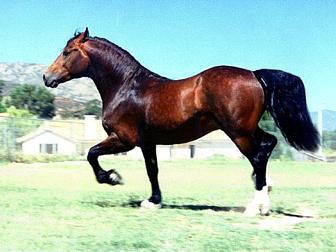
OVERVIEW
The Welsh Cob in its ideal form is a larger version of the Welsh Mountain Pony. Although its exact origin, like many native breeds, is unknown, the modern horse gets much of its character from Spanish blood and the Norfolk Roadster. In the 12th Century, Gerald of Wales said of the Welsh Cob, they are "swift and generous steeds ridden into battle by the brave Welsh Princes and Chieftains." Established as a breed by the 15th Century, the Welsh Cob became essential to Welsh farm life including ploughing, hauling and transportation in saddle and harness. Later they were used in war for hauling guns and equipment over steep and rocky terrain.
PHYSICAL DESCRIPTION
Standing above 13.2 hands high, the Welsh Cob's general character is strong, hardy, and active. Its head is of pony character with bold eyes set far apart. The Cob has a strong, arched neck with a body that is slightly thick and very compact and strong through the ribs. Some silky feathering is found around the heel, but wiry, course hair is objectionable. The flex found in the hock joints allows the horse excellent action, giving it a noble character in harness.
ORIGIN
The precise origins of the Welsh Cob are unknown. It can be said, however, that much of the Cob's character comes from the Welsh Mountain Pony. During the 11th and 12th centuries the pony was crossed with Spanish horses to create a larger horse, the Powys Cob and the Welsh Cart Horse. With the mix of the Norfolk Roadsters and Yorkshire Coach Horse, including a touch of Arabian in the 18th and 19th centuries, the modern Welsh Cob was produced. There are four stallions in particular that have influenced the Welsh Cob: Trotting Comet, foaled in 1836, Cymro Llwyd, a dun foaled in 1850, Alonzo the Brave, foaled in 1866, and True Briton, foaled in 1830.
INTERESTING FACTS
Before stallion licensing began in 1918, the stallion breeding stock for Welsh Cobs was selected by trotting matches. Speed was recorded by stopwatch over a certain distance, with the top stallions named appropriately for such matches: Comet, Flyer, Express. One favorite course was the route from Cardiff to Dowlais in Britain - 35 miles uphill - which the best horses could complete in under 3 hours with no slackened pace.
INFLUENCES
1. Spanish
2. Arabian
3. Welsh Mountain Pony
For more information:
The Welsh Pony & Cob Society
Welsh Pony & Cob Society of America